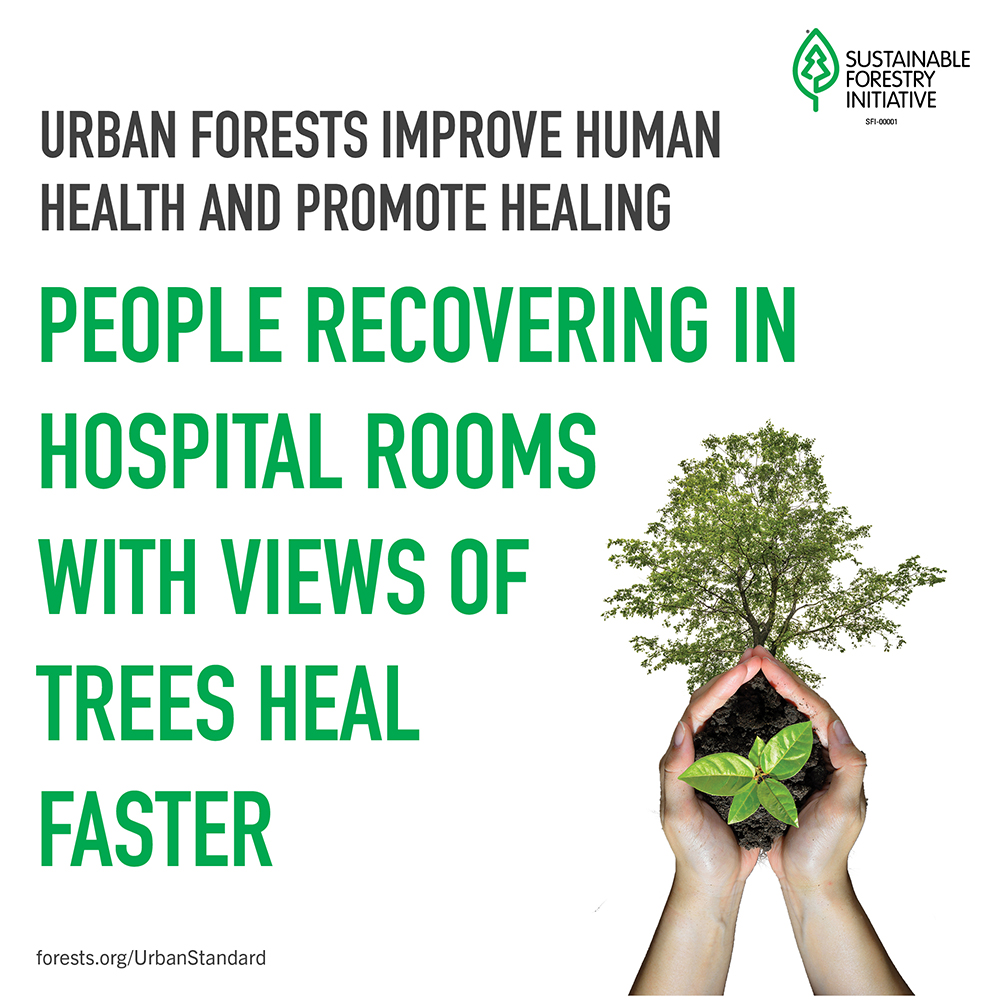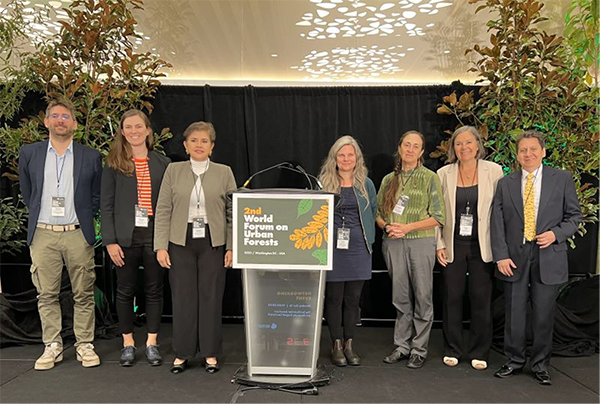By Paul Johnson, Vice President of Urban and Community Forestry and Career Pathways at SFI
Participating in the 2nd World Forum on Urban Forests (WFUF) alongside Kathy Abusow, President and CEO of SFI, made me feel like we were letting the whole world know that SFI is active in urban and community forestry. The forum, held in late October in Washington DC, had the theme “Greener, Healthier and Happier Cities for All.”

This theme was chosen to highlight the importance of building inclusive and accessible cities where the benefits provided by urban forests and trees are universally available. It’s a theme that’s also reflected in the new SFI Urban and Community Forest Sustainability Standard. This new SFI Standard is designed to contribute to the resiliency and sustainability of communities, large and small, using trees and forests as natural solutions to improve community health and address the challenge of climate change.
Delivering this message in person at the WFUF was especially gratifying. The audience was filled with people I’ve known for years who understand the vital role urban and community forests play in the lives of people all over the world. Urban and community forests enhance human health, mitigate climate change, and support diversity.
To support these outcomes, we recently launched the SFI Urban and Community Forest Sustainability Standard on August 16, 2023. More than two years ago, SFI and our partners — American Forests, Arbor Day Foundation, the International Society of Arboriculture, the Urban and Community Forestry Society, and Tree Canada — identified a need and an opportunity to provide leadership in urban and community forestry. Our 22-member expert task group and all the people that piloted and commented during the development process made significant contributions to helping us get to where we are today. Together, we worked to raise the profile of the importance of urban forests as green infrastructure and nature-based solutions to help address human health, environmental sustainability, and diversity, equity and inclusion.

Healthy urban and community forests mean healthier people
Increased urban tree cover is related to lower rates of asthma and diabetes. Urban forests have also been shown to reduce stress and improve heart rates and blood pressure. People recovering in hospital rooms with views of trees heal faster.
Mitigating climate change with urban and community forests
An urban forest canopy reduces temperatures and heat. Combatting dangerous heatwaves and lowering temperatures helps cities adapt to climate change. Urban forests also intercept and absorb stormwater, which reduces flooding and keeps cities greener and cooler.
Urban and community forests help promote diversity and equity
The National Institutes of Health says urban trees promote social interaction and a sense of community, leading to increased use of outdoor spaces and better access for all.
One of the ways forestry can help address diversity and equity is by offering pathways to rewarding green careers. That’s one of the reasons there were plenty of people at the WFUF who are part of SFI’s career pathways programming and the Project Learning Tree Network (PLT). PLT and PLT Canada are educational initiatives of SFI and their career supports are a key area of responsibility for me as the Vice President of Urban and Community Forestry and Career Pathways at SFI.
I’m so happy that part of my professional life is spent encouraging youth to pursue rewarding green careers in forestry in ways that encourage more diversity, equity, and inclusion in forestry. Minorities in Agriculture, Natural Resources and Related Sciences (MANRRS) and SFI have a memorandum of understanding designed to ensure that Americans of color underrepresented in the sector have greater opportunities for rewarding careers in forestry and conservation.
SFI and MANNRRS released Black Faces in Green Spaces: The Journeys of Black Professionals in Green Careers to help youth learn about the many jobs in the forest and conservation sector. We also hope to advance the diversity conversation within the sector by sharing many inspiring stories from historical and current environmental heroes.
Looking back for inspiration, looking forward for opportunity
Urban and community forestry has never been more relevant or more visible and 2023 will go down as a historic year in the history of urban and community forestry. In 2023 alone, we completed the SFI Urban and Community Forest Sustainability Standard and the related third-party certification options. SFI was also selected as one of the 12 National Pass-through Partners with the US Forest Service for Inflation Reduction Act Urban and Community Forestry funding.
We are continuing to expand our SFI community to include urban forest decisionmakers like mayors, city managers, CEOs, school board and post-secondary officials, and sustainability officers. We know our success will come from working with everyone from the people who wear the boots on the ground to the people who sit in boardrooms and at city hall.

On a personal note, I have been selected to serve on the US Forest Service National Urban and Community Forestry Advisory Council, which is the steward of the Ten-Year Urban Forest Action Plan. We are also expanding our SFI urban and community forestry team to include two director-level positions.
As 2023 draws to a close, I can say unequivocally that joining SFI has been one of the best professional decisions I’ve ever made and I’m excited for 2024 and the future of urban and community forestry.
SFI at the 2nd World Forum on Urban Forestry
Moderator: Kathy Abusow, Sustainable Forestry Initiative
- The relationship between green infrastructure and public health in land use planning — Anna Sunding
- Urban Forests for Life: The public policy in Bogotá — Martha Perdomo
- Nature in Urban Planning for Better Human Health — Kathleen Wolf
- Fulfilling the promise of urban forestry: How do we align site-level urban forest management to achieve city-wide plans? — Corinne Bassett
- On tree-related microhabitats in urban areas — Thomas Campagnaro
- Bogotá’s pruning plan, an essential planning and governance instrument — Germán Tovar Corzo
Panel 3: Paving the Way for a Global Urban Forestry Movement
Dan Lambe, Arbor Day Foundation, Moderator
Ingrid Coetzee, ICLEI – Local Governments for Sustainability
Paul Johnson, Sustainable Forestry Initiative
Suzanne Ozment, World Resources Institute
